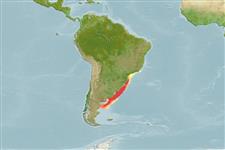分類 / Names
俗名 | 同種異名 | Catalog of Fishes(屬, 種) | ITIS | CoL | WoRMS | Cloffa
Elasmobranchii
板鰓亞綱 (鯊魚與魟魚) (sharks and rays) >
Squatiniformes (Angel sharks)
扁鯊目 (Angel sharks) >
Squatinidae (Angel sharks)
琵琶鮫科 (Angel sharks)
Etymology: Squatina: Latin for skate, which angel sharks superficially resemble, presumably tautonymous with Squalus squatina Linnaeus 1758 (no species mentioned). (See ETYFish); guggenheim: In honor of the Guggenheim Institución (presumably the present-day John Simon Guggenheim Foundation), which apparently funded the “study trip” (translation) that led to the description of this species. (See ETYFish).
Environment: milieu / climate zone / depth range / distribution range
生態學
海洋; 半鹹淡水 居於水底的; 深度上下限 4 - 360 m (Ref. 57911), usually 4 - 266 m (Ref. 55667). 亞熱帶的; 20°S - 45°S, 68°W - 40°W (Ref. 57911)
Southwest Atlantic: southern Brazil and Argentina.
西南大西洋: 巴西南部與阿根廷.(參考文獻 26282)
Length at first maturity / 大小 / 重量 / 年齡
Maturity: Lm 74.2 range ? - ? cm
Max length : 129 cm TL 雄魚/尚未辨別雌雄; (Ref. 57911); 130.0 cm TL (female); common length : 89.0 cm TL 雄魚/尚未辨別雌雄; (Ref. 55667)
簡短描述
檢索表 | 型態特徵 | 形態測量圖
This species is distinguished by the following characters: with a single (or multiple in juveniles) row of enlarged, conical and morphologically distinct dermal denticles over dorsal longitudinal midline, from midlength of the pectoral fin base to origin of first dorsal fin (in some specimens, to origin of caudal fin); dorsal midline denticles are with enlarged and rounded basal plate, 3-4 times diameter of other dorsal denticles, crown with several median ridges (10-12), and crown apex acute and smooth, without ridges (vs. dorsal midline denticles on trunk morphologically similar to other trunk denticles and barely organized in a row in S. occulta and S. argentina); differs from S. occulta by having larger and fewer white blotches on dorsal surface, without surrounding blackish rings (i.e. absence of ocelli-like markings) and smaller in size at maturity, from 73.0-80.0 cm TL (vs. greater than 100.0 cm TL in S. occulta);
differs from S. argentina by its ligther background colour, light to dark brown (vs. dark brown to reddish brown), with larger and fewer white blotches over dorsal surface, with a pair of enlarged, conical and morphologically distinct dermal denticles between spiracles (vs. interspiracular surface covered by smaller dorsal denticles, no enlarged denticles), the lower number of tooth rows with 18-22 vertical rows in both upper and lower jaws, tooth formula 9-9 to 11-11/9-9 to 11-11 (vs. 12-12/12-12 in i>S. argentina), and with a straight external pectoral fin margin (vs. with convex anterior half of external margin). Colouration: dorsal color pattern of light to dark brown background, with several white, creamy-white or yellowish large and rounded blotches variable in size (between one-half to 1.5 times eye-length) on entire dorsal surface (Ref. 95520).
Bony fishes were the main food followed by crustaceans and molluscs (Ref. 55667). Ovoviviparous (Ref. 50449). Adult males are characterized by the presence of a patch of small spines near the tip of the pectoral fins (Ref. 86510).
卵胎生的.(參考文獻 50449)
Ovoviviparous, embryos feed solely on yolk (Ref. 50449). Only the left ovary is functional (Ref. 57911).西南大西洋: 巴西南部與阿根廷.(參考文獻 26282)
Vaz, D.F.B. and M.R. De Carvalho, 2013. Morphological and taxonomic revision of species of Squatina from the Southwestern Atlantic Ocean (Chondrichthyes: Squatiniformes: Squatinidae). Zootaxa 3695(1):001-081. (Ref. 95520)
IUCN 瀕危狀態 (Ref. 130435)
瀕危 (EN) (A2bd); Date assessed: 07 June 2018
人類使用
漁業: 商業性
工具
特別的報告
下載 XML
網路資源
Estimates based on models
Preferred temperature (Ref.
123201): 11.7 - 20.4, mean 15.8 °C (based on 228 cells).
Phylogenetic diversity index (Ref.
82804): PD
50 = 0.5000 [Uniqueness, from 0.5 = low to 2.0 = high].
Bayesian length-weight: a=0.00676 (0.00293 - 0.01558), b=3.07 (2.88 - 3.26), in cm total length, based on LWR estimates for this Genus-body shape (Ref.
93245).
營養階層 (Ref.
69278): 4.4 ±0.80 se; based on food items.
回復力 (Ref.
120179): 非常低的, 最小族群倍增時間超過14 年 (Fec=4-10).
Fishing Vulnerability (Ref.
59153): Very high vulnerability (78 of 100).
Nutrients (Ref.
124155): Calcium = 18.6 [3.4, 85.9] mg/100g; Iron = 0.762 [0.196, 2.146] mg/100g; Protein = 20.1 [18.0, 22.1] %; Omega3 = 0.441 [0.196, 0.945] g/100g; Selenium = 26.6 [7.5, 70.5] μg/100g; VitaminA = 11.3 [4.1, 33.1] μg/100g; Zinc = 0.478 [0.237, 0.881] mg/100g (wet weight);
